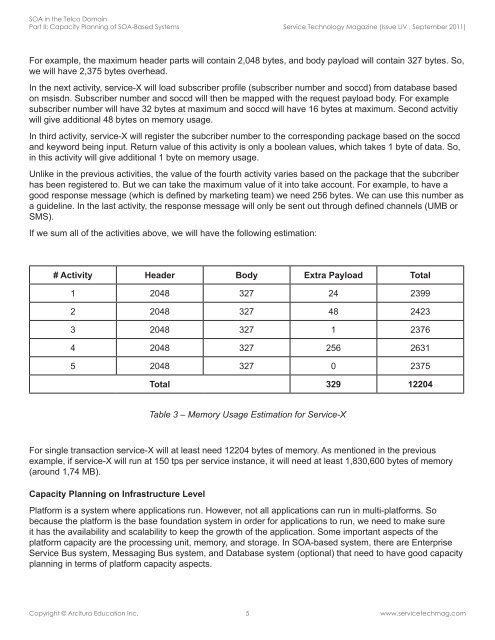Capacity Planning of SOA-Based Systems - Service Technology ...
Capacity Planning of SOA-Based Systems - Service Technology ...
Capacity Planning of SOA-Based Systems - Service Technology ...
Create successful ePaper yourself
Turn your PDF publications into a flip-book with our unique Google optimized e-Paper software.
<strong>SOA</strong> in the Telco Domain<br />
Part II: <strong>Capacity</strong> <strong>Planning</strong> <strong>of</strong> <strong>SOA</strong>-<strong>Based</strong> <strong>Systems</strong><br />
<strong>Service</strong> <strong>Technology</strong> Magazine (Issue LIV , September 2011)<br />
For example, the maximum header parts will contain 2,048 bytes, and body payload will contain 327 bytes. So,<br />
we will have 2,375 bytes overhead.<br />
In the next activity, service-X will load subscriber pr<strong>of</strong>ile (subscriber number and soccd) from database based<br />
on msisdn. Subscriber number and soccd will then be mapped with the request payload body. For example<br />
subscriber number will have 32 bytes at maximum and soccd will have 16 bytes at maximum. Second actvitiy<br />
will give additional 48 bytes on memory usage.<br />
In third activity, service-X will register the subcriber number to the corresponding package based on the soccd<br />
and keyword being input. Return value <strong>of</strong> this activity is only a boolean values, which takes 1 byte <strong>of</strong> data. So,<br />
in this activity will give additional 1 byte on memory usage.<br />
Unlike in the previous activities, the value <strong>of</strong> the fourth activity varies based on the package that the subcriber<br />
has been registered to. But we can take the maximum value <strong>of</strong> it into take account. For example, to have a<br />
good response message (which is defined by marketing team) we need 256 bytes. We can use this number as<br />
a guideline. In the last activity, the response message will only be sent out through defined channels (UMB or<br />
SMS).<br />
If we sum all <strong>of</strong> the activities above, we will have the following estimation:<br />
# Activity Header Body Extra Payload Total<br />
1 2048 327 24 2399<br />
2 2048 327 48 2423<br />
3 2048 327 1 2376<br />
4 2048 327 256 2631<br />
5 2048 327 0 2375<br />
Total 329 12204<br />
Table 3 – Memory Usage Estimation for <strong>Service</strong>-X<br />
For single transaction service-X will at least need 12204 bytes <strong>of</strong> memory. As mentioned in the previous<br />
example, if service-X will run at 150 tps per service instance, it will need at least 1,830,600 bytes <strong>of</strong> memory<br />
(around 1,74 MB).<br />
<strong>Capacity</strong> <strong>Planning</strong> on Infrastructure Level<br />
Platform is a system where applications run. However, not all applications can run in multi-platforms. So<br />
because the platform is the base foundation system in order for applications to run, we need to make sure<br />
it has the availability and scalability to keep the growth <strong>of</strong> the application. Some important aspects <strong>of</strong> the<br />
platform capacity are the processing unit, memory, and storage. In <strong>SOA</strong>-based system, there are Enterprise<br />
<strong>Service</strong> Bus system, Messaging Bus system, and Database system (optional) that need to have good capacity<br />
planning in terms <strong>of</strong> platform capacity aspects.<br />
Copyright © Arcitura Education Inc. 5 www.servicetechmag.com




